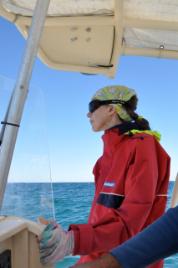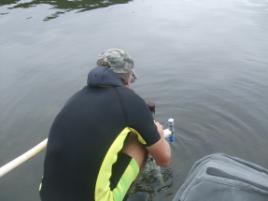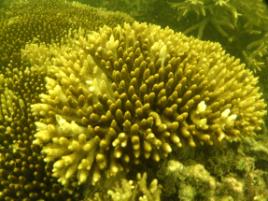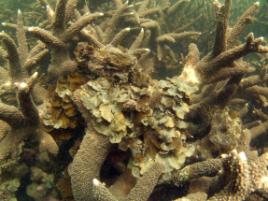Reef to suffer from Queensland flood waters
Published on 13 January, 2011
Flood waters that are engulfing the Keppel Islands off the Capricorn Coast may have a significant impact on the reef, according to a CQUniversity reef researcher.
Dr Alison Jones, based at the Centre for Environmental Management in Rockhampton, believes while river flood plumes are a seasonal occurrence at the mouth of the second largest catchment in Australia, the Fitzroy River, such a huge volume of water, combined with calm wind conditions could result in major coral bleaching and dieback.

On watch - Alison Jones monitors the effects of flood waters on the reef at the Keppel Islands.The freshwater plume currently reaches down six metres or more at the Keppel Islands which Jones believes is concerning, however the long-lasting effects on the reef may not be known for some months.
"We are monitoring the situation very closely here in the Keppels with help from JCU (James Cook University), DERM (Department of Environmental Resource Management), UQ (University of Queensland), GBRMPA (Great Barrier Reef Marine Park Authority) and CSIRO (Commonwealth Scientific and Industrial Research Organisation).
"We already have quite extensive data on what coral cover and species diversity exists in the Keppels before the flood and have now conducted more intense pre-flood studies of five sites spread throughout the region to determine the impacts. These studies are combined with permanent salinity and temperature loggers, passive samplers and sediment traps at the same five reefs. JCU, UQ and CSIRO have now also focused their water sampling efforts at the same sites.
"We are monitoring which reefs start to show effects when, and will conduct surveys post-flood in about May to see what permanent effects there are from the flood."
Jones said while it is hard to see what is going on from the surface, below the warm, turbid freshwater meniscus there is a clearer band of cooler saltwater and it is possible to see the corals. She said she was also using remote underwater cameras to look at the corals.
Corals can be affected by flood plumes in a number of ways. The fresh water lowers the salinity which can either bleach the coral or kill the polyp directly. Corals that are exposed to extremely low salinity water will shed algae, mucous and tissues. The CQUniversity study hopes to reveal at what salinity level this occurs.

Researchers deploy salinity loggers at Clam Bay off the Capricorn Coast.The flood plume also carries fine clay particles which if these reach the reef, will settle on the coral colonies causing the polyp to use valuable energetic resources to clean them off. This all happens at a time when they are also making less food from photosynthesis because of less light due to the turbidity above them. This can in effect starve them.
However, Jones said it was important to note that most of the sediment from the Fitzroy is deposited at the river mouth and it depends on wind conditions how much reaches the reefs.
The other effect from flood plumes is the toxicants that are carried in the water column, but more importantly, those carried on the fine clay sediment particles. These pollutants include chemicals that can affect the photosynthetic mechanisms of the algae which live in the coral polyp. Heavy metals are thought to stress the coral and make it susceptible to disease over the 12-24 months following the flood.
More importantly though is the impact of high levels of nutrients that accompany the plumes. Although some nutrients in the form of chlorophyll is food for corals, too much causes the surrounding macro-algae to outcompete them.
"A shift from mostly reef-building corals to mostly macro-algae can take year to decades to recover back to a mostly coral-dominated state. This is the situation that we most want to avoid and although reefs are in a constantly shifting equilibrium between corals and macro-algae, too much nutrient in the form of rotting vegetation or fertilizers can have devastating effects," Jones said.
"While we may lose some of the corals on local reefs, there are always some pockets of corals that will survive and as in the 1991 Rockhampton flood, it is these pockets that will seed reef regeneration on surrounding impacted reefs.

Floodwaters have already impacted corals at 1m depth at Halfway Island reef flat.Jones said that they would just have to wait and see what the impacts are first and then possibly target those pockets for increased protection from anchoring, fishing and collecting.
"One of the most detrimental activities on inshore reefs is the removal of rare coral species which can reduce the functional diversity of the whole system. Coral collectors target rare corals and in the Keppels which is an isolated and virtually closed reef system, this can be extremely damaging to reef recovery."
On a positive note, the floods may have a beneficial effect on the levels of baitfish in the region, providing plenty of fish stock for recreational fishermen later in the year. It is the territorial coral dependent fish species that may not do so well.


